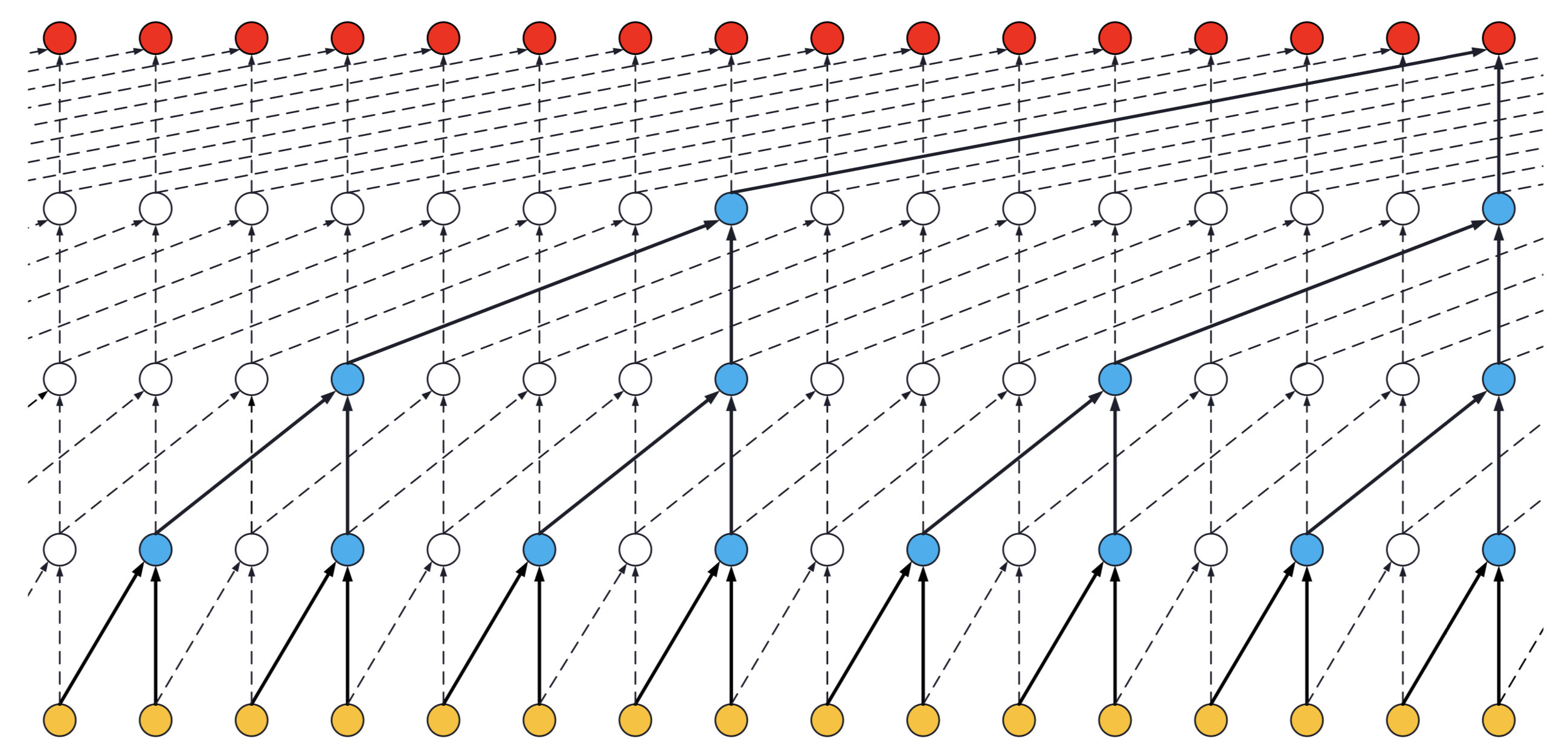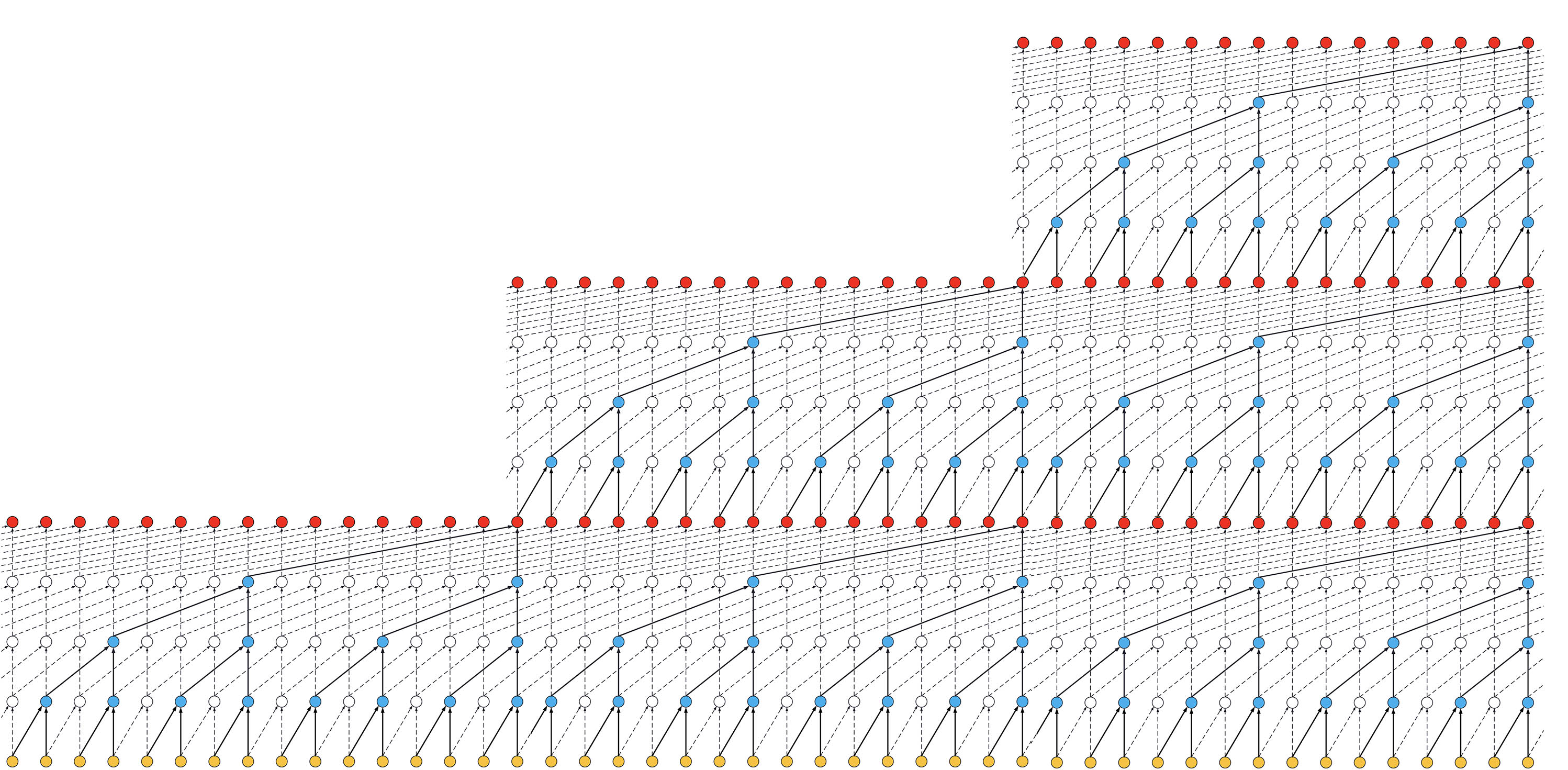The explanation and graph in this README.md refers to Keras-TCN.
Temporal Convolutional Network with tensorflow 1.13 (eager execution)
- TCNs exhibit longer memory than recurrent architectures with the same capacity.
- Constantly performs better than LSTM/GRU architectures on a vast range of tasks (Seq. MNIST, Adding Problem, Copy Memory, Word-level PTB...).
- Parallelism, flexible receptive field size, stable gradients, low memory requirements for training, variable length inputs...
 Visualization of a stack of dilated causal convolutional layers (Wavenet, 2016)
Visualization of a stack of dilated causal convolutional layers (Wavenet, 2016)
tcn = TemporalConvNet(num_channels, kernel_size, dropout)
num_channels: list. For example, ifnum_channels=[30,40,50,60,70,80], the temporal convolution model has 6 levels, thedilation_rateof each level is[1, 2, 4, 8, 16, 32], and filters of each level are30,40,50,60,70,80.kernel_size: Integer. The size of the kernel to use in each convolutional layer.dropout: Float between 0 and 1. Fraction of the input units to drop. The dropout layers is activated in training, and deactivated in testing. Usingy = tcn(x, training=True/False)to control.
3D tensor with shape (batch_size, timesteps, input_dim).
It depends on the task (cf. below for examples):
- Regression (Many to one) e.g. adding problem
- Classification (Many to many) e.g. copy memory task
- Classification (Many to one) e.g. sequential mnist task
- Receptive field = nb_stacks_of_residuals_blocks * kernel_size * last_dilation.
- If a TCN has only one stack of residual blocks with a kernel size of 2 and dilations [1, 2, 4, 8], its receptive field is 2 * 1 * 8 = 16. The image below illustrates it:
 ks = 2, dilations = [1, 2, 4, 8], 1 block
ks = 2, dilations = [1, 2, 4, 8], 1 block
- If the TCN has now 2 stacks of residual blocks, wou would get the situation below, that is, an increase in the receptive field to 32:
 ks = 2, dilations = [1, 2, 4, 8], 2 blocks
ks = 2, dilations = [1, 2, 4, 8], 2 blocks
- If we increased the number of stacks to 3, the size of the receptive field would increase again, such as below:
 ks = 2, dilations = [1, 2, 4, 8], 3 blocks
ks = 2, dilations = [1, 2, 4, 8], 3 blocks
Each task has a separate folder. Enter each folder one can usually find utils.py, model.py and train.py. The utils.py generates data, and model.py builds the TCN model. You should run train.py to train the model. The hyper-parameters in train.py are set by argparse. The pre-trained models are saved in weights/.
cd adding_problem/
python train.py # run adding problem task
cd copy_memory/
python train.py # run copy memory task
cd mnist_pixel/
python train.py # run sequential mnist pixel task
cd word_ptb/
python train.py # run PennTreebank word-level language model taskThe training detail of each task is in README.md in each folder.
The task consists of feeding a large array of decimal numbers to the network, along with a boolean array of the same length. The objective is to sum the two decimals where the boolean array contain the two 1s.
The copy memory consists of a very large array:
- At the beginning, there's the vector x of length N. This is the vector to copy.
- At the end, N+1 9s are present. The first 9 is seen as a delimiter.
- In the middle, only 0s are there.
The idea is to copy the content of the vector x to the end of the large array. The task is made sufficiently complex by increasing the number of 0s in the middle.
The idea here is to consider MNIST images as 1-D sequences and feed them to the network. This task is particularly hard because sequences are 28*28 = 784 elements. In order to classify correctly, the network has to remember all the sequence. Usual LSTM are unable to perform well on this task.
In word-level language modeling tasks, each element of the sequence is a word, where the model is expected to predict the next incoming word in the text. We evaluate the temporal convolutional network as a word-level language model on PennTreebank.
- https://github.com/philipperemy/keras-tcn (TCN for keras)
- https://github.com/locuslab/TCN/ (TCN for Pytorch)
- https://arxiv.org/pdf/1803.01271.pdf (An Empirical Evaluation of Generic Convolutional and Recurrent Networks for Sequence Modeling)
- https://arxiv.org/pdf/1609.03499.pdf (Wavenet paper)


